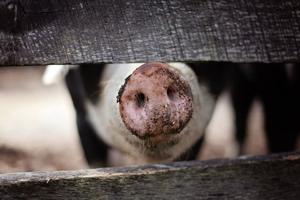
By Jim Leffman via SWNS
A pig heart kept alive for more than 24 hours outside the body could offer hope for people waiting for transplants, scientists say.
Human hearts have a maximum of six hours before they need to be transplanted but the latest breakthrough could change all that.
The improvements to preservation made could mean more hearts available for transplants.
There are around 50,000 people worldwide waiting for a new heart with only 5,000 operations a year.
There is a bottleneck in the availability of suitable donor hearts, partly due to the very short time window for transplantation once the heart is removed from the dead donor.
The current ‘gold standard’ for preserving donor hearts is cold static storage (CSS), where hearts are kept on ice until transplantation.
Transplantation is most successful when CSS lasts less than six hours before the heart or its blood vessels undergo damage.
Periods up to 12 hours are sometimes possible but require mechanical life support such as extracorporeal membrane oxygenation (ECMO) for several days on the recipient.
Prolonging the storage period beyond six hours without the need for ECMO would thus be a medical breakthrough.
However, researchers at the University of Michigan Medical School have managed to keep a pig’s heart alive for more than 24 hours using a process called normothermic ex-vivo heart perfusion (NEHP).
Dr. Robert Bartlett, an emeritus professor and head of the Extracorporeal Life Support Laboratory at the University said: “If translated to humans, this would be a major improvement to the six-hour-long time window in standard clinical practice.”
Rather than cooling the heart, NEHP involves pumping oxygenated, nutrient-rich fluid, perfusate, derived from blood plasma through them at room temperature until transplantation.
Drugs and tissue-repairing stem cells can be delivered to the heart through the perfusate, reports the study, published in Frontiers in the journal Cardiovascular Medicine.
Over the past seven years, the Extracorporeal Life Support Laboratory has worked on steadily extending the shelf-life of donor hearts through improvements to NEHP.
For the study, Dr. Bartlett and his colleagues kept the hearts of 30 immature and 10 juvenile pigs alive for various periods with experimental variants of NEHP.
All control hearts died between 10 and 24 hours after removal from the donor, while all hearts that had been maintained with modifications to standard NEHP survived for the full 24 hours.
The variants to NEHP that seemed to have worked included haemofiltration, plasma exchange, and intermittent left atrial perfusion or iLA which were major improvements that enabled the routine preservation of hearts to beyond one day.
But they say that which of the latter three methods is better can’t be answered yet.
Dr. Bartlett said: “I think the major difference will be when we extend our experiments beyond 24 hours, where perhaps plasma exchange is better as larger toxins can be removed.
“iLA also seems a major improvement, as in principle it would allow NEHP to be used on hearts that have suffered injuries or have borderline function in the donor.”
Dr. Alvaro Rojas-Pena, a research investigator at the same institute and the corresponding author of the study added: “This work could ultimately increase the donor pool.
“First, by extending the preservation time, thus overcoming limitations due to logistics.
“Second, by giving an objective assessment of the viability of each potential donor heart, to reduce the number that currently aren’t used when it’s not clear how well they function inside the donor.
“The major challenge for clinical application will be the validation of the methods in humans.
“To this end, we have started to work with human hearts rejected for transplantation.”


